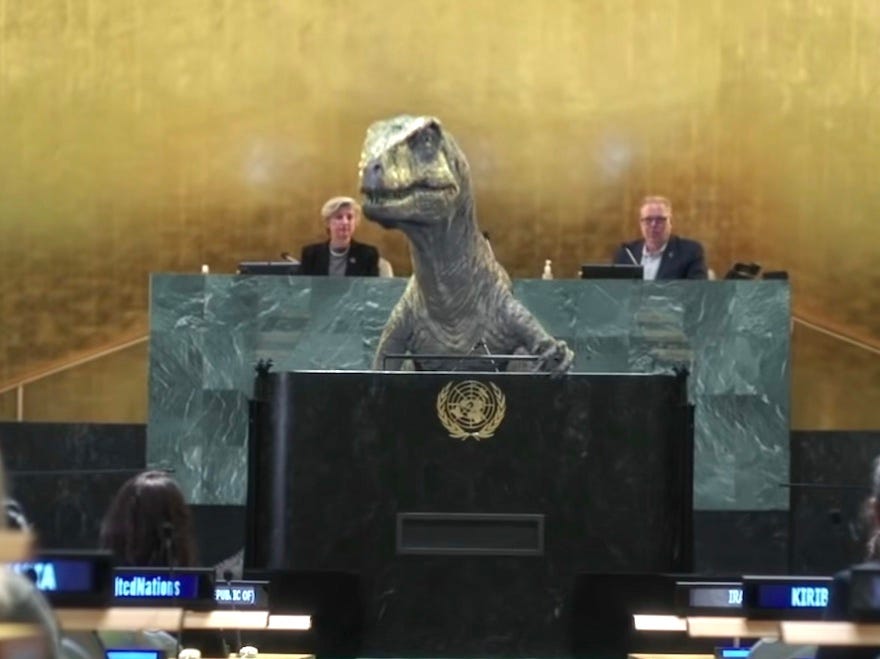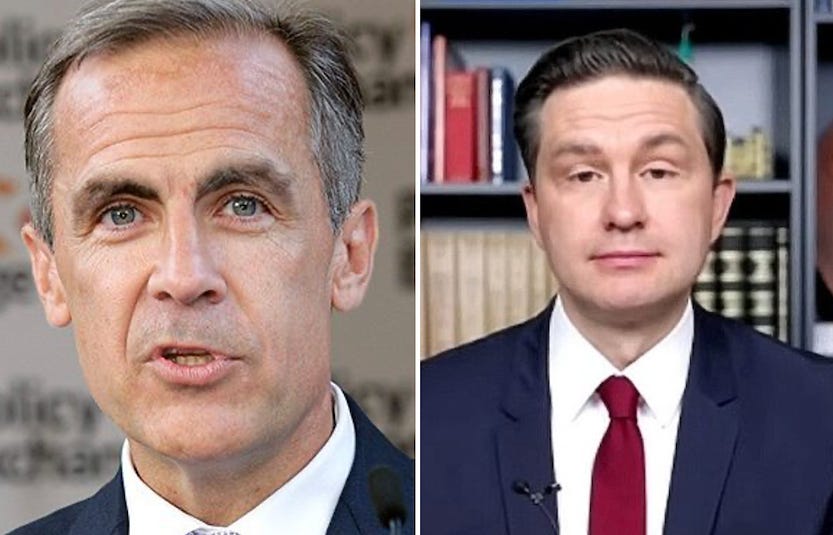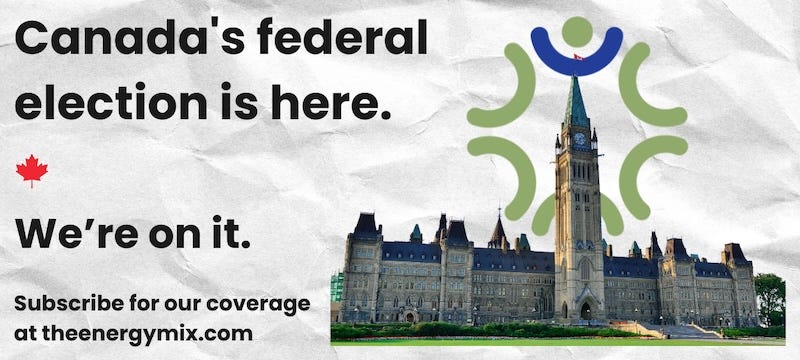On Climate and Energy, Canada Needs Pragmatics, Not Performance Pieces
Both major federal parties say they’ll get stuff done on energy. But in a climate emergency amplified by the rogue regime in the White House, we need Canada doing the right stuff.
There’s still a long way to go before the votes are counted in Canada’s April 28 federal election, longer still before we see whether the party platforms have any more substance than the mostly virtual paper they’re written on.
But if some of the campaign pledges and side conversations we’ve seen over the last week are still standing on the morning of April 29, we may be entering a period where endless, performative debate gives way to pragmatic action and getting stuff done. And just in time to help build a new “coalition of the willing”, an alliance of countries standing against Donald Trump’s moves to reshape the global economy in his own chaotic image.
It's so easy and, let’s be honest, so tempting during an election campaign to react to every issue or policy statement through a partisan lens. But that’s a line that non-profits and charities are necessarily careful not to cross, and you won’t see Energy Mix Productions endorse any candidate or party in this or any other election.
That still leaves the door open for an essential conversation about the practical actions and real-world change we need over the next four years, and what the party platforms tell us about how they plan to respond.
The Answers You Should Want to Hear
Let’s start with some of the enduring questions and priorities that should be on all of our minds, whether or not there’s an election on:
• What are the most practical, achievable, affordable paths that can still transform Canada’s economy and energy systems and get us to zero emissions by 2050?
• How do we make sure that everything we do tackles multiple, interconnected crises at once, so that our actions on energy and climate change make day-to-day life safer, more affordable, and more fair and equitable for all?
• What are the common sense steps that will make a real difference in the manufactured global crisis brought to us by the rogue regime in the White House—to protect and strengthen Canadian sovereignty, restore international cooperation on issues from climate change to health to nature protection and more, and help lead the way to a new international trading bloc that leaves Donald Trump and his clown car full of henchfolk behind?
• How do we build on the moment of national unity Trump has handed us to restore trust and cohesion across the country and its regions? Not by ignoring or averaging out our differences of opinion and partisanship, but by finding the deeper values and priorities (like, y’know, not becoming a 51st state) that unite us?
With this line of questioning, we can assess the major candidates and their platforms based not on any prior party preference, but on the future they seem most likely to deliver if we give them the chance. For better and for worse, the Liberal and Conservative camps have made it pretty easy to compare and contrast—one of them by reading their lips, the other by trying to read their minds.
Read Their Lips
On the Conservative side, party leader Pierre Poilievre has done us all the great courtesy of eliminating all ambiguity about his proposed “Canada First” National Energy Corridor. On a campaign stop in St. John’s April 1, he fully endorsed a letter from 14 fossil fuel CEOs that demanded the next federal government declare a “Canadian energy crisis” and “use all its available emergency powers” to fast-track fossil fuel export projects while gutting federal regulation.
The Conservatives pledged to repeal the federal Impact Assessment Act and the West Coast tanker ban, set a six-month approval deadline for major megaprojects along a pre-approved fossil energy corridor, walk away from the federal emissions cap on oil and gas, and eliminate an industrial carbon tax that has been praised as one of the country’s most effective emission reduction measures.
With those words, Poilievre also eliminated any hope that the new export pipelines he’s promised will go into service until long after the Trump-induced trade crisis is over, and demand for oil and gas has gone into permanent decline. Savanna McGregor, Grand Chief of the Algonquin Anishinabeg Nation Tribal Council, warned that Poilievre’s promise to “pre-approve” projects along the corridor would “nearly paralyse” the work rather than speeding it up.
“Surely he knows Canada’s constitution requires Indigenous consultation, accommodation, and ultimately consent to build major infrastructure inside his National Energy Corridor?” she wrote for a Toronto Star. “How can there be consultation (to say nothing of accommodation and consent) if the corridor is ‘pre-approved’ before anyone has the blueprints for what infrastructure will be built and where?”
Moreover, Poilievre’s boldly performative (performatively bold?) promise assumes a level of commitment we haven’t seen from some of the companies that are backing these projects. Andrew Leach, a leading energy and environmental economist based at the University of Alberta, recently took a deep dive into the 10 projects the Conservative leader wants to fast-track—and identified the ones that stalled out when their proponents failed to submit their environmental assessment paperwork. After going into the detailed history on one of them, he asks:
So, tell me dear readers: how is a @PierrePoilievre government going to overcome this hurdle? How, in a year, are they going to approve a project that, for 8+ years, has refused to submit a single environmental assessment document and has officially withdrawn its project?
Even when the companies are doing their homework, a new network of oil and gas pipelines along a corridor no one has agreed to isn’t the policy we need or want. Not unless we’re happy to see Canada’s greenhouse gas emissions increase through 2035.
One of the enduring lessons of Donald Trump’s return to power is that when they tell us what they plan to do, what pain and damage and loss they plan to inflict, it’s a good idea to believe them. And Poilievre, to his credit, is leaving no doubt.
Read Their Minds
The assessment is actually a bit more complicated on the Liberal side. Not because party leader Mark Carney’s energy and electricity sovereignty plan doesn’t hit some badly-needed touchpoints, but because the devil is in the details. And the details are all about delivery, an area where his party hasn’t always excelled over the last decade.
In his announcement last Wednesday in Calgary, Carney cast an east-west electricity grid as a “nation-building project” to “secure Canadians’ access to affordable, reliable, clean, Canadian electricity”. He committed to investing in the country’s “conventional and clean energy potential”, touted a new First and Last Mile Fund to kick-start critical mineral projects and build the clean energy supply chain, and pledged to issue decisions on new megaprojects within two years.
The Liberal Party news release and backgrounder ran long on language about clean and community energy, short on references to fossil fuels, and contained not a single nod to pipelines. In Calgary, Carney told media Canada would “choose its partners carefully, and work with those who share our values,” iPolitics reported at the time.
“Ignoring climate change,” he added, is “not only morally wrong, but economically wrong.”
The balance of stated priorities in the Liberals’ policy pronouncement was something the energy and climate crowd could only have dreamed of 10 years ago. But the announcement still received an appropriately cautious response.
“We’re glad to see the Liberal Party highlighting that investing in clean electricity capacity is critical for our sovereignty and economy,” Climate Action Network Canada Executive Director Caroline Brouillette said in a release. But “conventional energy” is still “a euphemism for continuing the status quo approach of expanding fossil fuels,” which translates into “pipelines going across Indigenous lands, many billions sunk into stranded assets, and climate harm caused by increased emissions that will come back to hurt us in the form of floods and wildfires.”
Hey, Let’s Try an Industrial Strategy!
The good news is that this is an industrial strategy, not an energy strategy, which means it has a chance of pushing past the policy paralysis on climate by making emission reductions the “co-benefit” rather than the focal point.
But if the Liberals win government and get a shot at putting action behind their words, everything will depend on the way the plan is developed, pitched, and implemented to make sure the climate gains and associated community benefits they promise actually materialize. Some questions to watch out for:
• How will every project genuinely contribute to a sovereign Canada’s energy and economic security by making energy more affordable, supporting local economies and job creation, boosting climate resilience, and reducing the climate pollution that disrupts our communities with ever-intensifying climate disasters?
• What steps will Canada consistently take to reduce demand for energy and resources before figuring out how to supply the rest, and how will that work be funded?
• How will the government move past checkbox consultation to make sure critical mineral or other renewable resource megaprojects keep community goals front and centre—in Indigenous country, and everywhere else?
• What standards will Ottawa enforce through a fast-tracked, single-window review process to protect health and well-being, look out for local ecosystems, and ensure that real benefits flow to communities that are too often left behind when megaprojects come to town?
• And where will a new government come down on measures like Sen. Rosa Galvez’ proposed Climate-Aligned Finance Act, which died on the order paper in the last Parliament and must absolutely be reintroduced—and adopted—when the new term begins?
Pro tip: All of these priorities—all of them—trace back to a least-cost energy strategy that relies on energy efficiency, renewables, and energy storage, not fossil fuels.
Mitchell Beer traces his background in renewable energy and energy efficiency back to 1977, in climate change to 1997. Now he and the rest of the Energy Mix team scan 1,200 news headlines a week to pull together The Energy Mix, The Energy Mix Weekender, and our weekly feature digests, Cities & Communities and Heat & Power.
Video of the Week

Trans Mountain Dominates as Canada’s Fossil Fuel Support Nears $30B for 2024
Three Big Energy Shifts that Can Transform and Modernize Canada’s Economy
Transparent Solar Panels Edge Closer to Turning Windows into Power Sources
Carney Touts Trade, Poilievre Backs Fossil CEOs in Duelling Plans for Cross-Canada Corridor
Quadruple Funds for Greener Homes, Offer Deep Retrofit Grants, New Report Urges Ottawa
U.S. Utilities Can Blend Hydrogen in their Gas Supply Without Informing Customers
UN Agency Redefines Economic Growth to Factor in Fossil Fuel Depletion
Canada’s Energy Security Depends on Political Coordination, Not Power Lines: Lourie
Tariffs May Force Economic Reckoning, New Practices in B.C. Forest Sector
Canada will no longer cover travel costs of experts it nominates to UN's climate science body (Canadian Broadcasting Corporation)
Climate crisis on track to destroy capitalism, warns top insurer (The Guardian)
Trump’s EPA Plans to Stop Collecting Greenhouse Gas Emissions Data From Most Polluters (ProPublica)
Four Senate Republicans Vow To Defend Climate Law Tax Credits (Bloomberg)
A stunning number of electric vehicle, battery factories are being cancelled (Washington Post)
Base Power lands $200M for rapidly growing home battery business (Canary Media)
Could robots help offshore wind take off in Japan? (CBC What On Earth)
AtkinsRéalis looks to recruit autoworkers as trade war intensifies (Globe and Mail)
Mexico looks to step up fracking in face of Donald Trump threat (Financial Times)
Extension of huge offshore windfarm in Sussex, UK approved (The Guardian)
‘Land grabs’ in Africa replaced by ‘carbon grabs’, says bank president (Financial Times)
TotalÉnergies Completes Multiple Renewable Energy Asset Acquisitions (Rigzone)








